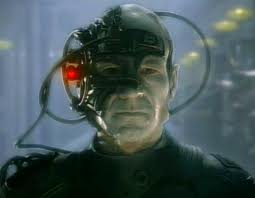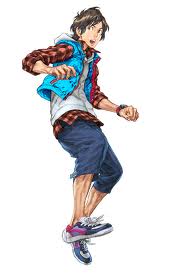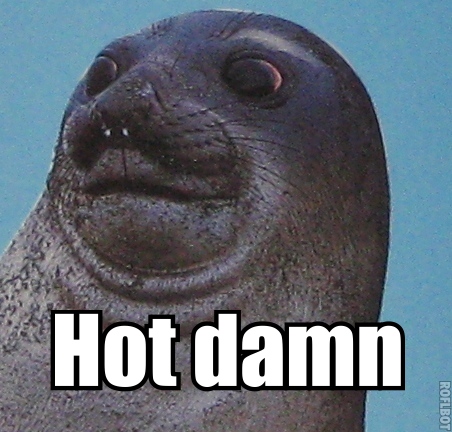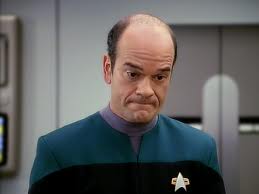The name Star Trek (not to be confused with Star Wars, a trilogy of great movies which spawned decent prequels, many toys, and a horrid T.V show) is often associated with the usual name for anyone who loves fantasy/sci-fi oriented entertainment.
I'm writing this to explain why Star Trek is not just a great show for nerds, but one of the best franchises ever conceived.
There are 5 different series of Star Trek, each very unique. They have different main characters, different settings, and different characteristics that make each one unique. Everyone has a favourite series, and the uniqueness of each series helps you choose your favourite.
But first, I need to fill you in on some information about certain termonology I'll be using in this (long) essay.
@@@@@@@@@@@@@@@@@@@@@
The Star Trek Dictionnary.
The Federation: A group of species who live by the directive of maintaining peace and good relations within the universe. Composed of species (that i will describe later) such as Humans, Vulcans, some blue guys I can't think of right now, Trill, and other unimportant species.
Vulcans: Pointy eared aliens who have a very strict control over their emotions, and are ususally very rational and peaceful (also grumpy).
Romulans: Biologically distant relatives of th Vulcans, they look like Vulcans but with small crests on their forehead. They aren't as emotionally reserved as their cousins, and are not part of the Federation, rather one of the larger political powers in the Star Trek universe (alongside the Federation, the Klingons, the Dominion, Cardassians, etc...)
Klingons: A warrior species who value honour over anything else. They are quick to anger, and fight often. They'd rather die in battle than be captured. They have huge forehead crests, and are not part of the Federation.
Trill: A species with leopard type streaks down their forhead and shoulders. Otherwise they look like humans. 1 in 10 Treill are selected to become part of a symbiant, where a worm type species who contains memories from several lifetimes is placed in the Trill host's body. The host now has all the life experience that the other hosts had.
Founders: A group of shape shifters who create their own clone armies and delegates (who have names I can't recall), and also have a firm control of the Gamma Quadrant (more on this later).
The four Quadrants: The four parts of the Star Trek universe are the Alpha, Beta, Gamma, and Delta quadrants. The are arranged in squares, with the Gamma quadrant in the top left, Delta top right, Beta bottom right, and Alpha bottom left. The Federation main base is on the dividing line of the Alpha and Beta quadrant. Let me stress that these qudrants are huge, and the Alpha and Beta quadrants are the only primarily visited by the Federation. The only shortcut to the Gamma quadrant is through a stable wormhole (featured prominently in DS9) and the Delta quadrant is really f**cking far away and the Voyager crew got stranded there in a teleportation accident.
Cardassians: Reptile looking humanoids who occuped the planet Bajor (and the Bajorians) and a nazi type dictatorhip involving labour camps and such. They created Terok Nor, a space station later known as DS9.
Bajorans: Human looking people with nose crests, and an elaborate ear piece on their right ear. Artistic and peaceful, they were under the rule of the oprresive Cardassians for at least a decade.
Borg: One of the best things about Star Trek. The Borg are a race of many different species who were assimilated into a collective concsious and injected with robotic implants. Also, they pilot big f**king cubes. Cubes.
Q: A race of god-like aliens who like to harass the Federation. They are really, really powerful, but are more mischievous than tyrannical.
Enterprise: There are lots of Star Trek ships named Enterprise. Three series revolve around a ship named Enterptrise. The only other star ship of note is Voyager, which is very suitable considering what it goes through.
Replicators: Star Trek has things that make food and objects appear out of thin air.
Transporters: Self-explanatory.
Phasers: Their equivalent of guns.
Ferengi: Troll looking aliens who value money over anything else. Their customs make money a large factor in politics, crime, and their general happiness. They look hilarious, and are partly the reason Star Trek looks very stupid to a casual observer.
@@@@@@@@@@@@@@@@@@@@@
The Original series.
In 1966, a man named Gene Roddenberry created Star Trek, a new sci-fi series about a Federation of species who explore the universe looking to establish good relations with the rest of the universe.
Estimated starting time period: 2250.
This series is what people who have no experience with Star Trek associate with the name. I recommend you don't view this series first, for a couple a reasons.
This series is the first to be aired, yet only the second in the seriex timeline. It took place on a ship called the Enterprise.
Remember, this is 1966. Sexism was still prominant in this era, and thusly, all woman on this show wore really short skirts. I mean really short.
The racially diverse cast (Asian, Russian, African, American, Scottish, etc...) all had really bad accents.
The plots of each episode were mostly about having the crew confused about some new event/species, then right before they get destroyed, they figure some s**t out and save the day.
The props, setting, clothing, and makeup were really bad. Computers were carboard boxes, ships were plastic models, and Klingons were black people. That last one is really funny, but still very racist at the same time.
This series has lots of movies based upon them, and I'd recommend the latest one, which is a prequel, which came out really recently.
Also, Captain Kirk had sex almost every episode. With a strange alien he had never met before. So, there's always that.
My personal opinion:
Honestly, I'd only recommened this series to people who really like the other series, and still, only because you go in knowing that it will be really bad, so therefore really funny.
It was monumental for the time, and has some impactful moments/episodes (for the time, seeing a black woman and a white man kiss was incredible).
4/10 for recommendation.
@@@@@@@@@@@@@@@@@@@@@@
Star Trek: The Next Generation.
Estimated starting time period: 2360.
Essentially Star Trek 2.0.
This series was made in 1987, to revitalize a pretty much dead franchise. It worked really, really well.
With much better props, costumes, and non-racist aliens, this series is some of Star Trek's best.
This series replaced the old captain William Shatner with Patrick Stewart, a bald more diplomatic character as opposed to the cocky and bold personality of Shatner.
This series was set almost 100 after The Orginal series. It also took place on a ship called the Enterprise.
This series became a more contemperary version of the old series, which the later series still retain. This series is one of three where the main ship goes around exploring the immediate quadrants.
This series had 3 times as many episodes as the original, and is the longest running series to date.
It made many multi episode story arcs, and added interesting characters such a Data, an android trying to become more human, and Worf, the first Klingon in the Federation.
This series is the only other series to have any movies based upon them.
My personal opinion:
I'd recommend this to someone who wants to watch "classic" Star Trek, because this really retains that feeling as well as improving over the original in so many ways.
I personally find it less interesting as opposed to the other series, since it doesn't have some constant plot device adding depth to the plot, but that's just my personal opinion.
This series has many monumental moments in series canon, and the cast shows up regularily for cameos in other series.
I also find this series is more light-hearted than others, for there are less personal conflicts, and each epsiode usually restores the status quota each epsiode.
7/10 for recommendation (again, in my own opinion. 7 is by no means a bad score)
@@@@@@@@@@@@@@@@@@@@@
Star Trek: DS9
Estimated starting time period: 2370.
After the Cardassian occupation of bajor (think Hitler's Germany style) the Bajorans take over the nearby Cardassian Space station Terok Nor. They rename it Deep Space 9 (DS9). The series revolves around Federation Benjamin Sisko (the first African American Captain) being stationed to help the Bajorans (non Federation) re-establish DS9 as an economic and political point of interest in the quadrant.
Early on, the DS9 crew find a stable wormhole that leads to th Gamma quadrant, which makes DS9 a large political centerpoint for the Galaxy.
The access to the new uncharted terriotry gave the writers a lot of freedom to come up with new situations for episodes.
The extra scenes that weren't directly attributed to the main plot added a lot of personality to the main cast, making DS9 a great series for more personal conflicts.
DS9 had a lot darker tone, as well a more multi-part story arcs. The whole last two seasons were all set in the middle of a Federation/Klingon/Rommulan/etc.. vs the Founders war!
This series even brought old "The Next Generation" characters back as main characters to boost ratings.
My personal opinion:
I personally love this series for it's complex narritives and personal conflicts. It has a lot of complex characters, such as the shapeshifter Odo, and the symbiant Dax.
I wouldn't recommend this to someone new to Star Trek, becasue a lot of prior knowledge is required to fully appreciate some past event connections/species/etc...
However, this series took the franchise in a new direction by having the story (often, not always) take place on a space station, rather than a ship. The new concepts and narritive ideas makes this series one my personal favourite.
10/10 for recommendation.
@@@@@@@@@@@@@@@@@@@@@
Star Trek Voyager.
Estimated starting time period: 2378
Google Gilligan's Island. Now imagine how Star Trek could emulate that type of scenario.
Basically, because of a series of events too complex to describe here (if you are really interested, watch the first couple episodes, which are really good.) the Voyager crew, along with the Maquis (a group of rebels who the Federation have Voyager chase after) end up in the Delta quadrant.
The journey home is estimated to take 76 years.
The series revolves around Voyager making its way home, as well as being the first Federation contact with new species native to the delta quadrant.
Some things to remark about this series are the fact that this is the last Star Trek series chronologically (Star Trek wise), and for the only time in the franchise, feature a female Captain!
This series has more personal conflicts and a darker tone than "The Next Generation" but is still in between TNG and DS9 in those terms.
This series has lots of novel concepts because almost no old species from the old series are encountered on their journey home.
Notable crew members include a dis-assimilated Borg drone, and a holographic doctor.
Also, this series has the most time featuring the Borg, which became one of the most badass Star Trek villians ever.
My personal opinion:
I first got into Star Trek when my dad would insist on watching old Voyager re-runs instead of my shows. After I stopped complaining and started watching, I became transfixed by the series.
I would recommend this series to anyone who is new to Star Trek, along with TNG. Voyager is perhaps better for newcomers, since they meet new species alkost every episode, and therefore explain everything within that epsiode.
This series had a great premise, and if you do happen to start liking this series, the series' final episodes are so emotinonal, it takes the prize for best series ending.
Voyager will remain a great series for me, but DS9 takes the cake for me.
9/10 for recommendation.
@@@@@@@@@@@@@@@@@@@@@
Star Trek: Enterprise.
Estimated time period: 2150.
Yep. 150 years from now we will get to experience this series.
A prequel to the other series, Enterprise tells the story of the first human deep space explorers, in a pre Federation time.
This series is the closest thing you will get to a modern T.V show (it was made in 2001, after Voyager just ended) and is the only Star Trek to be shot in HD.
This series has by far the darkest tone of any of the series. It had the advantage of more mature story arcs, considering humanity was risking its stance in the galaxy at the time, and the extra computer animation, props, and costumes/makeup/etc.. really made the series feel different from the rest.
The short four season-long run time of Enterprise was cause by lack of viewers, which might have been casued by the whole "I'm a prequel and you're going to like it" business.
This series had season-long story ar in season 3 when humanity faced possible extinction because of the Xindi (6 different alien species who evolved at the same rate on the same planet to form the Xindi). This story arc was quite epic, and one of the biggest reasons to love this underrated show.
My personal opinion:
My dad told me to watch this series after Voyager, and I was a bit put off by the new modern/dark fell of it at first, but I began to see it's genius afterwards.
This series is great to jump into, but I'd still recommend other series for newcomers.
8/10 for recommendation.
@@@@@@@@@@@@@@@@@@@@@
Now I've been writing a lot lately, so I don't fell up to writing a good conclusion. Basically, read my post, choose a series, and jump in. You can find re-runs of every series (excluding the original series) on the Space channel (and most likely on-line somewhere), though you will have to record the one's at 4:00 AM.
Happy trekking (a term that is never justified throughout the entirety of the franchise).





